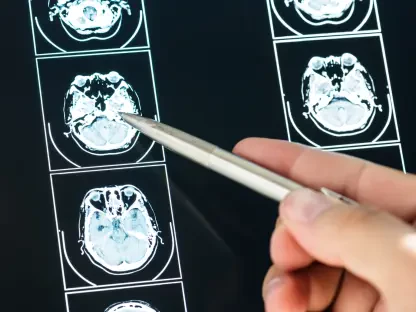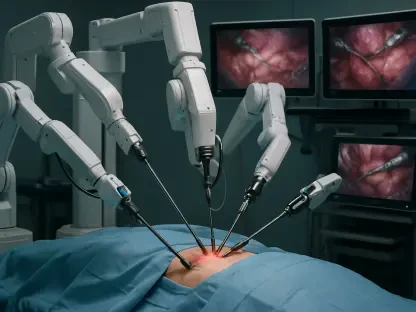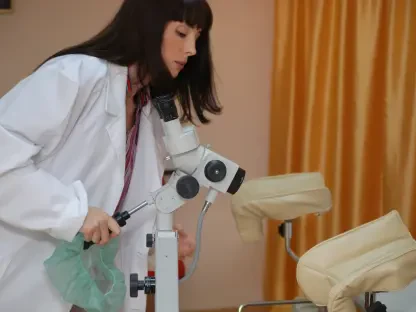In a world where skin cancer remains one of the most prevalent forms of cancer, a groundbreaking development in diagnostic technology is poised to transform the landscape of early detection and treatment, offering hope to millions. Basal cell carcinoma (BCC), the most common type, often requires invasive biopsies that can be painful, cause scarring, and delay critical care by weeks or even months. However, a new fluorescent imaging technique, recently detailed in a prestigious medical journal, offers a non-invasive, rapid, and highly accurate alternative. Developed by a dedicated team of researchers at a leading cancer center in New York, this innovative approach utilizes a topical fluorescent contrast agent known as PARPi-FL. By enabling detection through intact skin in mere minutes, this method promises to streamline diagnosis, reduce patient discomfort, and pave the way for immediate bedside interventions, marking a significant leap forward in dermatological care.
Addressing the Challenges of Traditional Diagnosis
The conventional process for diagnosing BCC has long been a source of frustration for both patients and healthcare providers due to its invasive nature and prolonged timelines. Biopsies, the current gold standard, involve surgically removing a sample of skin tissue for microscopic examination, often leaving patients with scars and requiring weeks for results to confirm whether a lesion is malignant. This delay can heighten anxiety and postpone necessary treatment, particularly in early-stage cases where timely intervention is crucial. Moreover, not all biopsies are necessary—many lesions turn out to be benign, subjecting patients to avoidable procedures. The need for a faster, less invasive diagnostic tool has never been more apparent, as it could transform how skin cancer is identified and managed, ensuring that patients receive care without the physical and emotional toll of traditional methods.
This new fluorescent imaging technique directly tackles these longstanding issues by offering a solution that prioritizes both speed and patient comfort. The PARPi-FL agent, applied topically to the skin, penetrates the dermal layers in just two to five minutes, producing a strong fluorescent signal in BCC lesions when viewed under specialized imaging equipment. Unlike biopsies, this method requires no cutting or removal of tissue, eliminating the risk of scarring and drastically reducing the time to diagnosis. What sets this approach apart is its ability to distinguish between malignant and benign tissues with remarkable precision, as demonstrated in extensive testing on human skin samples. By addressing the inefficiencies and discomfort of current practices, this technology represents a potential paradigm shift in how dermatologists approach skin cancer detection.
Safety and Efficacy in Preclinical Testing
Ensuring the safety of any new medical technology is paramount, and the developers of PARPi-FL have placed significant emphasis on validating its non-toxic profile. Preclinical toxicology studies conducted as part of this research have shown that the agent poses no harm to the skin and does not result in systemic side effects, even with repeated topical applications. This finding is critical, as it positions the fluorescent contrast agent as a viable option for widespread clinical use without the risks associated with more invasive diagnostic tools. Experts involved in the study have highlighted that the safety profile supports the potential for PARPi-FL to become a routine part of dermatological assessments, offering a method that patients can trust while minimizing the burden of multiple medical visits or procedures.
Beyond safety, the efficacy of this imaging technique has been rigorously tested across a variety of conditions and samples to confirm its reliability. Researchers applied the agent to ex vivo human tissues from different surgical contexts, including plastic surgery and Mohs surgery specifically for BCC cases, as well as fresh excisions of both benign and malignant tissues. The results consistently showed a clear distinction in fluorescent signals, with BCC lesions emitting a significantly stronger response compared to non-malignant areas. Further validation came from real-time in vivo imaging on animal models, where the topical application proved feasible in a living system. These findings underscore the potential of PARPi-FL to deliver accurate diagnoses swiftly, reducing the reliance on invasive biopsies and enhancing the ability to initiate treatment at the earliest possible stage.
Future Implications for Skin Cancer Care
The broader implications of this fluorescent imaging technology extend far beyond the immediate detection of BCC, hinting at a transformative future for skin cancer diagnostics as a whole. Researchers note that the target of PARPi-FL, a protein known as PARP1, is also overexpressed in melanoma, another prevalent and often more dangerous form of skin cancer. This opens the door to adapting the technique for distinguishing between malignant and benign pigmented lesions, potentially broadening its clinical applications. As the demand for precision medicine grows, integrating targeted fluorescent dyes with advanced in vivo imaging systems could redefine diagnostic accuracy across multiple skin conditions, ensuring that patients receive tailored care based on rapid, reliable assessments.
Looking ahead, the integration of this technology into routine practice could significantly streamline clinical workflows and improve patient outcomes on a global scale. The ability to diagnose BCC and possibly other skin cancers at the bedside without delay aligns with the ongoing shift toward non-invasive medical solutions. By eliminating the need for histopathologic confirmation in many cases, healthcare providers could offer immediate treatment options, reducing both costs and emotional strain for patients. The research team advocates for continued development and clinical trials to bring this innovation from the lab to the clinic, envisioning a future where such tools become standard in dermatology. This advancement stands as a testament to the power of molecular imaging to address critical gaps in care delivery.
Pioneering a New Era in Diagnostics
Reflecting on the strides made with PARPi-FL, it’s evident that this research marks a turning point in the battle against skin cancer through its focus on non-invasive detection. The successful preclinical validation of a topical fluorescent agent that can identify BCC in minutes without compromising safety sets a new benchmark for diagnostic innovation. The clear differentiation between malignant and benign tissues, coupled with the elimination of painful procedures, showcases a path toward more humane and efficient medical practices. This study lays the groundwork for a future where patients no longer face the anxiety of waiting weeks for biopsy results, as the technology promises answers in real time. Moving forward, the emphasis should be on accelerating clinical translation through expanded trials and regulatory approvals, ensuring that this method reaches healthcare settings swiftly. Additionally, exploring its applicability to other cancers like melanoma could further amplify its impact, offering a comprehensive toolset for dermatologists worldwide to enhance early intervention and save lives.









